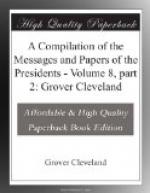While I have endeavored to make a plain statement of the disordered condition of our currency and the present dangers menacing our prosperity and to suggest a way which leads to a safer financial system, I have constantly had in mind the fact that many of my countrymen, whose sincerity I do not doubt, insist that the cure for the ills now threatening us may be found in the single and simple remedy of the free coinage of silver. They contend that our mints shall be at once thrown open to the free, unlimited, and independent coinage of both gold and silver dollars of full legal-tender quality, regardless of the action of any other government and in full view of the fact that the ratio between the metals which they suggest calls for 100 cents’ worth of gold in the gold dollar at the present standard and only 50 cents in intrinsic worth of silver in the silver dollar.
Were there infinitely stronger reasons than can be adduced for hoping that such action would secure for us a bimetallic currency moving on lines of parity, an experiment so novel and hazardous as that proposed might well stagger those who believe that stability is an imperative condition of sound money.
No government, no human contrivance or act of legislation, has ever been able to hold the two metals together in free coinage at a ratio appreciably different from that which is established in the markets of the world.
Those who believe that our independent free coinage of silver at an artificial ratio with gold of 16 to 1 would restore the parity between the metals, and consequently between the coins, oppose an unsupported and improbable theory to the general belief and practice of other nations and to the teaching of the wisest statesmen and economists of the world, both in the past and present, and, what is far more conclusive, they run counter to our own actual experiences.
Twice in our earlier history our lawmakers, in attempting to establish a bimetallic currency, undertook free coinage upon a ratio which accidentally varied from the actual relative values of the two metals not more than 3 per cent. In both cases, notwithstanding greater difficulties and cost of transportation than now exist, the coins whose intrinsic worth was undervalued in the ratio gradually and surely disappeared from our circulation and went to other countries where their real value was better recognized.
Acts of Congress were impotent to create equality where natural causes decreed even a slight inequality.
Twice in our recent history we have signally failed to raise by legislation the value of silver. Under an act of Congress passed in 1878 the Government was required for more than twelve years to expend annually at least $24,000,000 in the purchase of silver bullion for coinage. The act of July 14, 1890, in a still bolder effort, increased the amount of silver the Government was compelled to purchase and forced it to become the buyer annually of 54,000,000 ounces, or practically the entire product of our mines. Under both laws silver rapidly and steadily declined in value. The prophecy and the expressed hope and expectation of those in the Congress who led in the passage of the last-mentioned act that it would reestablish and maintain the former parity between the two metals are still fresh in our memory.




